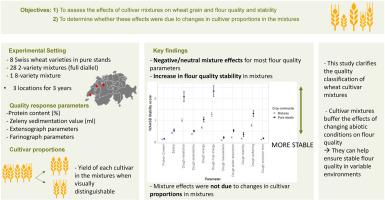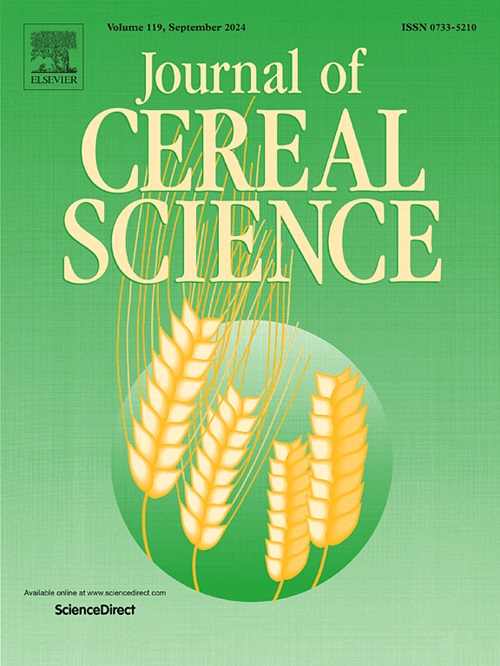品种混合稳定小麦烘焙品质
IF 3.7
2区 农林科学
Q2 FOOD SCIENCE & TECHNOLOGY
引用次数: 0
摘要
将多样性纳入农业系统是提高作物生产抗灾能力的一个有希望的途径。特别是,品种杂交作为稳定小麦产量的一种实用方法在欧洲引起了人们的注意。然而,它们对小麦烘焙质量的影响尚不清楚。研究了不同品种杂交对籽粒和面粉品质的影响。该试验涉及8种瑞士小麦品种,它们分别生长在纯林分、每种可能的2-品种混合和8-品种混合中。该实验在8个不同地点的环境中重复进行,以评估混合和纯林分烘焙质量的稳定性。结果表明,混合物的影响-即,平均性能与纯支架相比-对大多数面粉质量参数是中性或负的。此外,这些影响不是由于混合物中品种比例的变化,而是由于在混合物中生长而产生的品种特异性变化。最后,通过缓冲波动的环境条件的影响,混合物显著提高了面粉质量的稳定性。本研究首次对8种不同环境下的面粉品质进行了广泛的研究。这证明了品种混合在减轻非生物条件变化的影响和确保面粉品质稳定方面的潜力。本文章由计算机程序翻译,如有差异,请以英文原文为准。

Cultivar mixtures stabilize wheat baking quality
Integrating diversity into agricultural systems represent a promising way to increase the resilience of crop production. In particular, cultivar mixtures are gaining attention in Europe as a practical way to stabilize wheat yields. However, their impact on wheat baking quality remains unclear. This study examined the effects of cultivar mixtures on grain and flour quality. The experiment involved eight Swiss wheat cultivars grown in pure stands, in every possible 2-cultivar mixture, and in the 8-cultivar mixture. The experiment was repeated in eight year-by-site environments, allowing to evaluate the stability of baking quality in mixtures and pure stands.
The results showed that the effects of mixtures – i.e., average performance compared to pure stands – were either neutral or negative for most flour quality parameters. Furthermore, these effects were not due to changes in cultivar proportions within the mixtures, but rather to cultivar-specific alterations in response to being grown in a mixture. Finally, mixtures significantly increased the stability of flour quality, by buffering the effects of fluctuating environmental conditions.
This study is the first to extensively investigate flour quality in eight contrasting environments. It demonstrates the potential of cultivar mixtures to mitigate the effects of changing abiotic conditions and ensure stable flour quality.
求助全文
通过发布文献求助,成功后即可免费获取论文全文。
去求助
来源期刊

Journal of Cereal Science
工程技术-食品科技
CiteScore
7.80
自引率
2.60%
发文量
163
审稿时长
38 days
期刊介绍:
The Journal of Cereal Science was established in 1983 to provide an International forum for the publication of original research papers of high standing covering all aspects of cereal science related to the functional and nutritional quality of cereal grains (true cereals - members of the Poaceae family and starchy pseudocereals - members of the Amaranthaceae, Chenopodiaceae and Polygonaceae families) and their products, in relation to the cereals used. The journal also publishes concise and critical review articles appraising the status and future directions of specific areas of cereal science and short communications that present news of important advances in research. The journal aims at topicality and at providing comprehensive coverage of progress in the field.
 求助内容:
求助内容: 应助结果提醒方式:
应助结果提醒方式:


